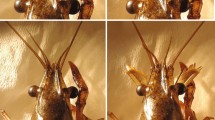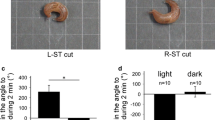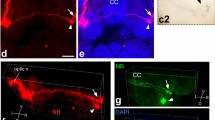Abstract
In the brain of the intact crayfish, three pairs of non-spiking giant interneurons (G1, G2, G3; NGIs) scarcely responded to substrate tilt about the longitudinal axis of the body either in the dark or in the presence of an overhead light. However, when the statolith was removed, these NGIs responded with depolarizing and hyperpolarizing potentials respectively to upward movements of the ipsilateral legs (2nd–5th pereiopods) and upward movements of the contralateral legs produced by substrate tilt. The relationships between the polarity of the potential and the direction of movement in the contralateral legs were opposite to those in the ipsilateral legs. The amplitude of the responses was proportional to the frequency (0.5-0.05 Hz) and amplitude of tilting. When the legs were moved unilaterally, the NGIs responded with depolarizing and hyperpolarizing potentials to upward movements of the ipsilateral legs and to upward movements of the contralateral legs, respectively. When the legs were moved bilaterally in the same direction by upward or downward movement of the substrate, the NGIs scarcely responded to the leg movements. A hypothetical model is presented to account for the pathways of sensory inputs to the NGIs and the role of NGIs in compensatory oculomotor system.
Similar content being viewed by others
References
Bush BMH (1965) Leg reflexes from chordotonal organs in the crab, Carcinus maenas. Comp Biochem Physiol 15: 567–587
Clarac F, Neil DM, Vedel JP (1976) The control of antennal movements by leg proprioceptors in the rock lobster, Palinurus vulgaris. J Comp Physiol 107: 275–292
Fay RR (1973) Multisensory interaction in control of eye-stalk rotation response in the crayfish (Procambarus clarkii). J Comp Physiol Psychol 84: 527–533
Furudate H, Okada Y, Yamaguchi T (1992) Reactivity of nonspiking giant interneurons to leg movements in the crayfish. Proceedings of the 3rd International Congress of Neuroethology (Montreal), Abstract No. 109
Glantz RM, Nudelman HB, Waldrop B (1984) Linear integration of convergent visual inputs in an oculomotor reflex pathway. J Neurophysiol 52: 1213–1225
Harreveld A van (1936) A physiological solution for freshwater crustaceans. Proc Soc Exp Biol Med 34: 428–432
Higuchi T, Hisada M (1973) Visual and geotactic contributions to oculomotor responses in the crayfish, Procambarus clarki. J Fac Sci Hokkaido Univ (Zool) 18: 495–506
Hisada M, Higuchi T (1973) Basic response pattern and classification of oculomotor nerve in the crayfish, Procambarus clarki. J Fac Sci Hokkaido Univ (Zool) 18: 481–494
Mellon DeF (1977) The anatomy and motor nerve distribution of the eye muscles in the crayfish. J Comp Physiol 121: 349–366
Mellon DeF, Lorton ED (1977) Reflex actions of the functional divisions in the crayfish oculomotor system. J Comp Physiol 121: 367–380
Neil DM (1982) Compensatory eye movements. In: Sandman DC, Atwood HL (eds) The biology of Crustacea, vol 4. Academic Press, New York, pp 133–163
Neil DM (1985) Multisensory interactions in the crustacean equilibrium system. In: Barnes WJP, Gladden MH (eds) Feedback and motor control in invertebrates and vertebrates. Croom Helm, London Sydney Dover, pp 277–298
Neil DM, Schöne H (1979) Reactions of the spiny lobster, Palinurus vulgaris to substrate tilt. II Input-output analysis of eyestalk responses. J Exp Biol 79: 59–67
Newland PL (1989) The uropod righting reaction of the crayfish Procambarus clarkii (Girard): an equilibrium response driven by two largely independent reflex pathways. J Comp Physiol A 164: 685–696
Okada Y, Yamaguchi T (1985) Eyestalk movements in the crayfish, Procambarus clarkii. Comp Biochem Physiol 81A: 157–164
Okada Y, Yamaguchi T (1987) Responses of nonspiking giant interneurons to magnetic field and visual stimulation in the crayfish. Zool Sci 4: 961
Okada Y, Yamaguchi T (1988a) Non-spiking giant interneurons in the crayfish brain: morphological and physiological characteristics of the neurons postsynaptic to visual interneurons. J Comp Physiol A 162: 705–714
Okada Y, Yamaguchi T (1988b) Nonspiking giant interneurons (NGIs) in the crayfish brain and their responsiveness to multimodal sensory inputs. Zool Sci 5: 1197
Okada Y, Yamaguchi T (1989) Response properties of nonspiking giant interneurons in the crayfish brain. Zool Sci 6: 1074
Okada Y, Furudate H, Yamaguchi T (1994) Multimodal responses of the non-spiking giant interneurons in the brain of the crayfish Procambarus clarkii. J Comp Physiol A 174: 411–419
Olivo RF, Jazak MM (1980) Proprioception provides a major input to the horizontal oculomotor system of crayfish. Vision Res 20: 349–353
Scapini F, Neil DM, Schöne H (1978) Leg-to-body geometry determines eyestalk reactions to substrate tilt. Substrate orientation in spiny lobsters. IV. J Comp Physiol 126: 287–291
Schöne H, Neil DM (1977) The integration of leg position-receptors and their interaction with statocyst inputs in spiny lobsters (reaction of Palinurus vulgaris to substrate tilt III). Mar Behav Physiol 5: 45–59
Schöne H, Neil DM, Scapini (1978) The influence of substrate contact on gravity orientation. Substrate orientation in spiny lobsters V. J Comp Physiol 126: 293–295
Schöne H, Neil DM, Scapini F, Dreissmann G (1983) Interaction of substrate, gravity and visual cues in the control of compensatory eye responses in the spiny lobster, Palinurus vulgaris. J Comp Physiol A 150: 23–30
Schöne H, Neil DM, Stein A, Carlstead MK (1976) Reactions of the spiny lobster, Palinurus vulgaris to substrate tilt (I.). J Comp Physiol 108: 113–128
Stewart WW (1978) Functional connections between cells as revealed by dye-coupling with a highly fluorescent naphthalimide tracer. Cell 14: 741–759
Wiersma CAG (1958) On the functional connections of single units in the central nervous system of the crayfish, Procambarus clarkii (Girard). J Comp Neurol 110: 421–471
Wiersma CAG, Oberjat T (1968) The selective responsiveness of various crayfish oculomotor fibers to sensory stimuli. Comp Biochem Physiol 26: 1–16
Wiersma CAG, Yamaguchi T (1966) The neuronal components of the optic nerve of the crayfish as studied by single unit analysis. J Comp Neurol 128: 333–358
Wiersma CAG, Yamaguchi T (1967) Integration of visual stimuli by the crayfish central nervous system. J Exp Biol 47: 409–431
Wiersma CAG, Yanagisawa K (1971) On types of interneurons responding to visual stimulation present in the optic nerve of the rock lobster, Panulirus interruptus. J Neurobiol 2: 291–309
Yamaguchi T, Okada Y (1990) Giant brain neurons of the crayfish: their functional roles in the compensatory oculomotor system. In: Wiese K et al. (eds) Frontiers in crustacean neurobiology. Birkhäuser, Basel Boston Berlin, pp 193–199
Yamaguchi T, Okada Y, Nakatani K, Ohta N (1984) Functional morphology of visual interneurons in the crayfish central nervous system. In: Aoki K et al. (eds) Animal behavior: neurophysiological and ethological approaches. Jpn Sci Soc Press. Springer, Berlin Heidelberg New York Tokyo, pp 109–122
York B, Yanagisawa K, Wiersma CAG (1972) Input sources and properties of position-sensitive oculomotor fibers in the rock lobster, Panulirus interruptus (Randall). J Exp Biol 57: 229–238
Author information
Authors and Affiliations
Rights and permissions
About this article
Cite this article
Furudate, H., Okada, Y. & Yamaguchi, T. Responses of non-spiking giant interneurons to substrate tilt in the crayfish, with special reference to multisensory control in the compensatory eyestalk movement system. J Comp Physiol A 179, 635–643 (1996). https://doi.org/10.1007/BF00216128
Accepted:
Issue Date:
DOI: https://doi.org/10.1007/BF00216128




